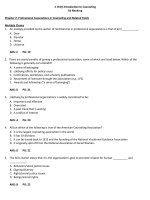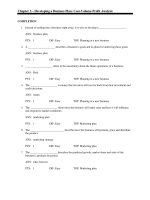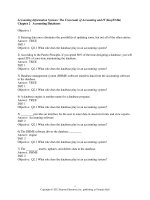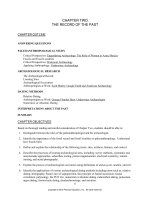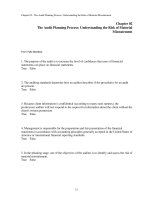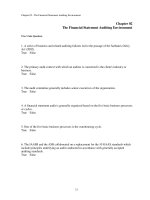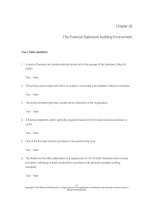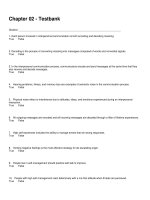Fundamentals of cognitive neuroscience a beginners guide 1st edition baars test bank
Bạn đang xem bản rút gọn của tài liệu. Xem và tải ngay bản đầy đủ của tài liệu tại đây (227.58 KB, 4 trang )
Chapter 2: A useful framework
Multiple Choice Questions (1-12)
1. It is sometimes said that selective attention is required for conscious experiences.
a. This statement is false because conscious experiences are unrelated to attention
b. This statement is false because, although occasionally selective attention does
lead to conscious experiences, in general conscious experiences are unrelated to
attention
c. *This statement is plausible because, although occasionally conscious experiences
may not require selective attention, in general attention does lead to conscious
experiences
d. This statement is true, conscious experiences cannot occur without attention.
2. When our attention is ‘captured’ by a feature of a stimulus, such as color or
movement, it is said to reflect which kind of process?
a. *bottom-up
b. bottom-down
c. top-up
d. top-down
3. When voluntary actions become automatic
a. it occurs rapidly without practice
b. executive control over them is improved
c. neuroimaging studies reveal an increase in cortical activity
d. *subcortical regions of the brain may take over the control of routine action
components
4. Limited capacity tasks are associated with
are associated with
.
a. unconscious events, self conscious events
b. self conscious events, unconscious events
c. *conscious events, unconscious events
d. unconscious events, conscious events
while large-capacity tasks
5. All of the following reflect limited capacity mechanisms except for
a. dual input tasks
b. *language vocabulary
c. ambiguous stimuli
d. competition between stimulus features
1
6. Brain imaging studies comparing activity from perceived versus imagined visual
events show that
a. perceptual events are correlated with activity in the occipital lobe while imagined
events are correlated with activation in the temporal lobe
b. imagined events are correlated with activity in the occipital lobe while perceived
ones are correlated with activation in the temporal lobe
c. imagined events did not produce significant activations while perceived events
were correlated with activations in the primary visual cortex
d. *imagined and perceived events activate similar brain regions.
7. Consolidation of short-term memories into long term memory is known to be
facilitated by
a. listening to music
b. drinking sufficient amount of water
c. *getting a full night’s sleep
d. eating healthy
8. The back half of the cortex is mostly involved in
a. motor functions
b. *sensory functions
c. executive functions
d. long term memory
9. According to the functional framework
a. sensory inputs enter the system only if attentional processes are devoted to their
perception
b. *both voluntary ‘top-down’ and automatic ‘bottom-up’ attentional processes are
shown in the framework diagram
c. motor or ‘action’ systems require central executive functions
d. all of the above
10. You have signed up to be a participant in an experiment. Your task is to draw on
your memory to answer questions such as: “visualize your front door and write
down on which side the doorknob is located” and “imagine your car and write down
the color of the front seats”. You decide that the experimenters are likely
investigating
a. Visual perception
b. *Visual imagery
c. Working memory
d. Executive function
2
11. An important aspect of voluntary and automatic actions is that
a. voluntary actions may become automatic with practice
b. automatic actions may require voluntary control in difficult situations (such as
walking with an injured ankle)
c. when our actions become automatic after practice, we often have less conscious
access to their details
d. *all of the above
12. According to the functional framework, stored memories, knowledge, and skills
a. interact with verbal rehearsal and visuospatial working memory processes
b. include perceptual and autobiographical memories
c. interact with central executive functions
d. *all of the above
Short Answer Questions (1-3)
1. What did the case of HM teach us about memory?
See pages 48-50 in the text.
By far the most scientific studies have been conducted with a patient we know as HM, who was
first studied by Brenda Milner and Herbert Scoville (Scoville and Milner, 1957). In the 1950s,
a treatment of last resort for severe, untreatable epilepsy was the surgical removal of part of the
temporal lobe. In the case of HM, the two hippocampi and some surrounding regions in the
middle temporal lobes were removed on both sides. Careful studies over decades showed that
HM was unable to store new autobiographical episodes – defined as memories of his conscious
life experiences. However, HM was able to learn new sensorimotor skills, called procedural
memories. Like Clive Wearing, HM’s ability to understand of the meaning of language and of
basic events was largely spared. Thus, his semantic memory – his ability to understand the
meaning of things – was not seriously impaired.
These studies with HM provided important information about the role of the memdial temporal
lobe in memory function. A second key benefit of the studies was the knowledge gained about
separable aspects of memory function: the fact that some aspects of memory, such as semantic
memory and procedural memory, were largely spared in HM while his autobiographical
memory was severely impaired. Thus, the processes that mediate those aspects of memory
function may involve differing brain regions.
2. Briefly explain the role of the ‘central executive’ shown in the functional framework
diagram.
See pages 38-40 in the text.
3
An analogy of an executive in a large company is provided in the text to explain the types of
functions performed by executive processes in the brain. They include having control over
mental processes such as paying attention to sensory input, making plans or solving problems,
and maintaining information in mind during the performance of a task.
3. What are some differences in brain activity for a new task as compared to when that
task has become well learned? What do you think this reflects in terms of mental
effort?
See pages 43-44 in the text.
For many years, we have known that voluntary actions become automatic with practice. Recent
neuroimaging studies have provided new information about brain activity patterns for tasks
that are newly learned and when they have become well practiced (see Figure 2.16). In these
studies, more activation is shown when a task is new or being learned. This activation –
especially in cortex – is reduced when the task becomes well learned.
4

